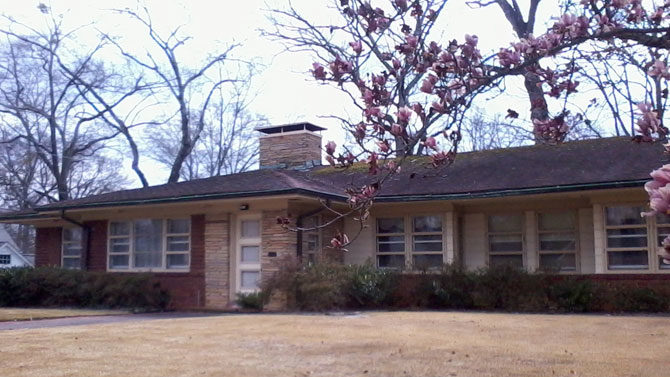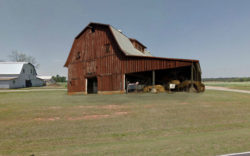Athens has plenty of architectural landmarks, but it always seems like some of them are on the chopping block. For as long as I’ve lived here, there has always been controversy over whether or not the steeple at St. Mary’s Episcopal Church, where R.E.M. played its first show, should stay or fall into further neglect. (I think we’ve silently opted for the latter.) The Murmur Trestle is in danger through demolition-by-neglect, and the Jittery Joe’s Roasting Co. building is in danger from new development.
The newest item on the Athens’ Most Endangered List: 232 University Dr. This high-style ranch house on the corner of University and Pinecrest is in danger of being demolished.
Five Points is a neighborhood known for its early 20th-century residential architecture. While this 1950s house is newer than the majority of houses in the neighborhood, it is still historic. (The threshold is 50 years.)
The house’s potential demolition has made surprisingly few waves, with some residents being opposed to the demolition and some just hoping that whatever replaces it will fit the mass and scale of the neighborhood, enhancing and respecting Five Points architectural history and not bitch-slapping it as some of the more recent “architecture” (I use the term loosely) has.
The house at 232 University, also known as the Stiles House, having been commissioned by Alwin Stiles in the 1950s, is one of the best examples of the ranch style in the Georgia. Today, we tend to ignore ranch houses because they are so ubiquitous—the most popular house style in the state—but pioneer houses like this set the trend.
Should every ranch house be saved? Certainly not. Should every structure that’s more than 50 years old be saved? No. Is this house worthy of being saved? Yes. According to Richard Cloues, deputy director of the Georgia Historic Preservation Office until he retired last June:
“The loss of this exceptional historic house would be a community and statewide architectural tragedy.”
While the ranch is an extremely popular style, there are very few such well-designed, trend-setting examples left in the state. The loss of this house will be a huge loss for the architectural history of our state and certainly our community.
Amy Kissane, director of the Athens-Clarke Heritage Foundation, says several members of the ACHF have been in touch with the Stiles family, the original owners of the house, in order to learn more about the history of the house and, hopefully, to the identify the architect. Athens-Clarke Commissioner Allison Wright, who represents part of Five Points, is imposing a 30-day moratorium on the demolition in hope that “someone might be willing to come forward and relocate this house.”
The plans for the new house seem to be in line with the character of Five Points: a one-and-a-half story cottage with dormers on a similar footprint as the current house. While the new plan seems to fit the neighborhood better than other recent additions to Five Points, the loss of the historic ranch currently there still turns my stomach.
Shenanigans in Boulevard
Residents in the Boulevard Historic District have been much more vocal in their dislike for the shenanigans at 321 Dubose Ave. Homebuilder and neighborhood resident Tom Ellis caused quite a stir by adding a behemoth addition onto the back of the home. The ACC Historic Preservation Commission allowed the controversial addition last April, going against the Planning Department’s recommendation, to the dismay of many neighbors who were against such a large addition to begin with.
It turned out to be even larger than expected. Ellis cites topography as the reason why the addition is nearly five feet taller than the approved plans. Since the addition no longer adheres to the plans approved by the HPC, Ellis had to resubmit modified plans to the HPC in February. Luckily for the Boulevard district and disgruntled neighbors, the modifications were denied. Ellis can appeal to the Mayor and Commission, modify the plans to satisfy the HPC or remove the addition and rebuild it as originally approved by the HPC in April.
Demolitions and additions may seem like small potatoes in the larger scheme, but these are the small steps that lead to loss of historic integrity and change the character of the neighborhoods and towns they’re in.
Like what you just read? Support Flagpole by making a donation today. Every dollar you give helps fund our ongoing mission to provide Athens with quality, independent journalism.










